2021 Lightweight Nakeds Spec Sheet Shootout

Summarizing five of todays hottest lightweight nakeds by the numbers.
Motorcycle.com’s Naked Summer continues in 2021 with our third naked bike test of the year. We started things off with the Middleweight Nakedbike Shootout, and followed that with the not-quite-heavyweight set of nakeds. But instead of moving up in size to the big boys in the field, we’ve decided to pivot in the opposite direction and bring you a matchup of the little naked bikes in the category – and by “matchup” we mean a comparison of each bike’s specs.
What are the motorcycles in question, you ask? This time around, we’ve brought together the BMW G310R, Husqvarna Svartpilen 401, Kawasaki Z400, KTM 390 Duke, and Yamaha MT-03. With a combined total of 189 horsepower, this quintet of motorcycles may not knock your socks off, but despite their low, entry-level prices, they all offer tech we might have considered premium a decade or two ago.
Don’t worry, we’ll bring you our usual comparison test shortly. For now, let’s whet the appetite by getting nerdy about what each bike offers… on paper.
Price
When you’re dealing with small displacement motorcycles, you’re typically dealing with new or newer riders with not a lot of cash. All five of these motorcycles slot in somewhere between $4599 (Yamaha) to $5699 (KTM). In between, we have the Kawasaki ($4999), BMW ($5045 for the base model), and Husqvarna ($5299).
Don’t mistake these inexpensive price tags to mean these bikes are cheap, though. Yes, these bikes were manufactured in Southeast Asia or India, and yes, some of the hardware used will seem basic, but all of them have the build quality we’ve come to expect from the respective brands. Besides, these are $5000 motorcycles. Let’s set some realistic expectations.
Engines
If you aren’t already familiar, we use the term Lightweight in reference to each motorcycle’s engine size. In this case, the engine sizes include a 313cc Single in the BMW, 321cc parallel-Twin in the Yamaha, a pair of 373cc Singles in the KTM and Husqvarna, and the 399cc parallel-Twin in the Kawasaki.
Not surprisingly, with the biggest engine in this field, the Kawasaki pulls the most power in the bunch… turning a whopping 43.2 hp at 10,200 rpm according to the Mickey Cohen Motorsports dyno. The KTM comes next with 39.8 hp at 8800 rpm, then the Husqvarna’s 37.9 hp at 9200 rpm, followed by the Yamaha’s 36.4 hp at 10,800 rpm, and the BMW’s 31.8 hp at 9500 rpm. You might be wondering why the 390 Duke and Svartpilen 401 have different numbers since they use the same engine. Manufacturing tolerances could be at play here but so could little differences like airbox size, routing, and placement. It just goes to show that no two engines are created equal.
Looking at torque numbers, displacement does *not* win out, as the smaller KTM’s 25.8 lb-ft bests the Kawasaki’s 24.5 lb-ft, and it hits sooner at 7000 rpm compared to the Zed’s 8200 rpm. Next is the Svartpilen’s 22.1 lb-ft at 7000 rpm, the MT-03 with 20 lb-ft at 9100 rpm, and the G310R brings up the rear with 19.7 lb-ft at 7500 rpm.
Suspension
If you want to know how manufacturers meet certain price points, it’s usually done by putting bare-bones suspension on its models. These lightweights are a good example. All are wearing shocks with basic preload adjustments as standard. However, one interesting feature of note is, except for the Kawasaki Z400, all the rest come with inverted forks. It wasn’t all too long ago where such a thing was reserved for fancy sportbikes and more expensive motorcycles. Progress is a wonderful thing, folks.
Still, no matter if it has an inverted or traditional fork, these budget suspensions are softly sprung by design, and between the fork and shock lie steel frames without much thought given to lateral rigidity. This actually provides a nice, comfortable ride for the general commuter, but for those who like to pick up the pace, you’ll start to butt up against their limitations. A standout amongst the crowd here is the Svartpilen 401 – it’s the only one with adjustments for compression and rebound, right there on top of the fork tubes. Not even its KTM cousin is similarly equipped.
Exactly how well these fork, shock, and chassis combinations work in the real world will have to wait for the full comparison test. We can’t give everything away right now.
Brakes
In addition to the budget suspension each bike is equipped with, most of the models here also get basic braking components. The Yamaha and Kawasaki are especially old-school, with the former wearing a 298mm disc and a simple twin-piston, pin slide caliper. The Z400 uses a similar caliper, but its single disc is 310mm. The European bikes here have stepped up their games, each wearing a radial-mount, four-piston caliper – tech formerly reserved for race bikes back in the day! The BMW caliper is mated to a 300mm disc, while the KTM and Husqvarna cousins both wear 320mm discs.
You’ll find always-on ABS on all of them and adjustable levers on the European bikes, but the KTM is the only one here with a feature called Supermoto mode, which disables the rear ABS so you can do rear wheel slides, just like the Supermoto gods. This, obviously, is an advanced technique.
Tech
These days it’s all but mandatory for new motorcycles to have some sort of electronic rider aids as standard, but in the case of these little bikes, minimalism is the name of the game. You won’t find traction control, lift control, slide control… or any other kind of control. Mainly because none of the bikes here are powerful enough to need any of it.
However, thanks to Euro 5 regulations, all the models here have ABS, and as mentioned before, the KTM has the ability to disable ABS in the rear. The 390 Duke is also the only one with a trick TFT display up front. The Husqvarna gets a nod for being equipped with an autoblipper, allowing you to shift in both directions without the clutch. This is a gamechanger even some bikes costing double the money don’t have. Oddly, the KTM isn’t similarly equipped.
Seat Height
Feeling in control is a big part of feeling comfortable on a motorcycle, and that starts with being able to put your feet on the ground. A low seat height is one way to get there. At 30.7 inches from the ground, the Yamaha comes in with the lowest seat height of our pack, although the BMW is available with an accessory seat, perched only 30.3 inches off the ground. Otherwise, the G310R’s standard seat is 30.9 inches high, same as the Kawasaki. The KTM comes next, raising the rider up to 32.7 inches, while the Husqvarna and its motocross-like seat perches the rider 32.9 inches up.
Also of note: there’s an accessory tall seat for the BMW, which puts your butt 31.5 inches high. And Kawasaki sells an Extended Reach seat for its Z that’s an inch taller as well.
Weight
In addition to being able to put your feet on the ground, being able to maneuver the bike helps build confidence. The lighter the bike, the easier it will be to manage. All five of these bikes are fairly light to begin with, and from top to bottom, all five of these models vary in weight by only 12 lbs. In case you’re wondering, yes, we (actually Ryan) weighed all of them on the official MO electronic scales with a full tank of gas.
At the top we’ve got the Yamaha at 371 lbs, followed closely by the KTM (363 lbs), BMW (362 lbs), Kawasaki (360 lbs), and finally the Husqvarna at 359 lbs. For some perspective, Yamaha lists its R1 at 448 lbs.
Fuel Capacity
Maybe a topic not often talked about with small-displacement motorcycles is how much gas they can carry. We all assume, and rightly so, that these bikes sip gas, but nonetheless, they’re still going to need refueling eventually. Having to constantly refuel can be a bit of a nuisance, at best; getting stranded because you ran out of gas can really put a damper on your day.
When we look at the fuel capacities, we see the Husqvarna carries a tiny 2.5 gallons of fuel on board, followed closely by the BMW’s 2.9 gallons. That’s not a lot of fuel. Look over at the next three bikes, and these carry enough gas to not cause range anxiety like an electric bike. The KTM holds 3.5 gallons, while the Yamaha and Kawasaki both carry 3.7 gallons.
And The Winner Is…
Oh, it’s far too early to call a winner on this one! This was just an appetizer to hold you over until the main dish. The numbers and figures can tell you a lot about a motorcycle, but there’s nothing quite like riding them all back-to-back to really understand how numbers on paper don’t necessarily translate to a winning motorcycle in the real world.
Still, we’re sure you’ll tell us what bike you think should win in the comments. In the meantime, be on the lookout for John’s excellent storytelling of how all five bikes shook out, and Matic’s excellent video-making of the shenanigans in the days to come.
Specs | BMW G310R | Husqvarna Svartpilen 401 | Kawasaki Z400 | KTM 390 Duke | Yamaha MT-03 |
|---|---|---|---|---|---|
| MSRP | $5045 (base) | $5299 | $4999 | $5699 | $4599 |
| Engine Type | Water-cooled, single-cylinder 4-stroke engine, four valves, two overhead camshafts and wet sump lubrication | Liquid-cooled, four-valve, DOHC, Single cylinder | 4-stroke, 2-cylinder, DOHC, liquid-cooled | Liquid-cooled, four-valve, DOHC Single cylinder, 4-stroke | liquid-cooled DOHC 4-stroke; 4 valves |
| Displacement | 313cc | 373cc | 399cc | 373cc | 321cc |
| Bore and Stroke | 76.2 mm x 60.96 mm | 89.0 mm x 60.0 mm | 70.0 mm x 51.8 mm | 89.0 mm x 60.0 mm | 68.0 mm x 44.1 mm |
| Compression Ratio | 10.9:1 | 12.6:1 | 11.5:1 | 12.6:1 | 11.2:1 |
| Horsepower (measured) | 31.8 hp at 9500 rpm | 37.9 hp at 9200 rpm | 43.2 hp at 10,200 rpm | 39.8 hp at 8800 rpm | 36.4 hp at 10,800 rpm |
| Torque (measured) | 19.7 lb-ft. at 7500 rpm | 22.1 lb-ft. at 7000 rpm | 24.5 lb-ft. at 8200 rpm | 25.8 lb-ft. at 7000 rpm | 20.1 lb-ft. at 9100 rpm |
| Fueling | Electronic fuel injection | Electronic fuel injection system, 46 mm throttle bodies with Ride-by-Wire system | DFI with 32mm throttle bodies | Electronic fuel injection system, 46 mm throttle bodies with Ride-by-Wire system | Fuel injection |
| Transmission | Constant mesh 6-speed gearbox integrated in crankcase | 6 speed w/autoblipper | 6-speed | 6 gears | 6-speed |
| Clutch | Multi-disc oil bath (anti-hopping) with self-reinforcement | multi-disc slipper clutch, mechanically operated | multi-plate wet clutch | multi-disc slipper clutch, mechanically operated | Constant mesh; wet multiplate clutch |
| Final Drive | Chain | Chain | Chain | Chain | X-ring chain |
| Frame | Tubular steel frame in grid structure with bolt-on rear frame | Steel trellis frame, powder coated | Trellis, high tensile steel | Steel trellis frame, powder coated | Tubular steel |
| Front Suspension | 41mm inverted fork, non-adjustable; 5.5 in. travel | WP 43 mm usd fork, compression, rebound adjustable, 5.6 inches of travel | Telescopic fork/4.7 in travel | 43mm WP inverted fork, non-adjustable; 5.6 inches travel | 37mm KYB inverted fork; 5.1-in travel |
| Rear Suspension | Single shock, preload-adjustable; 5.2 in travel | WP-USD Ø 43 mm, 5.6 inches travel | Uni-Trak swingarm/5.1 in travel | WP shock absorber, 5.9 inches travel | Single shock; 7-step preload adjustable, 4.9-in travel |
| Front Brake | Single disc, diameter 300mm, 4-piston fixed caliper, radially bolted | ByBre four piston, radially mounted caliper, brake disc Ø 320 mm | Single 310mm disc, twin-piston caliper, ABS | 320mm single disc, radial-mount 4-piston caliper, ABS w/Supermoto mode | Hydraulic single disc brake, 298mm; ABS |
| Rear Brake | Single disc, diameter 241mm, single-piston floating caliper | ByBre single piston, floating caliper, brake disc Ø 230 mm | Single 220mm disc, single-piston caliper, ABS | 230mm single disc, single piston, floating caliper, ABS w/Supermoto mode | Hydraulic single disc brake, 220mm; ABS |
| Front Tire | 110/70 R 17 | Pirelli Scorpion Rally STR 110/70 R 17 | 110/70 R 17 | 110/70 x 17 | 110/70 R17 |
| Rear Tire | 150/60 R 17 | Pirelli Scorpion Rally STR 150/60 R 17 | 150/60 R 17 | 150/60 x 17 | 140/70 R17 |
| Rake | 25.1° | 25.0° | 24.5° | 25.0° | 25.0° |
| Trail | 4.5 inches | 3.7 inches | 3.6 inches | 3.7 inches | 3.7 inches |
| Wheelbase | 54.3 inches | 53.4 ± 0.6 inches | 53.9 inches | 53.4 ± 0.6 inches | 54.3 inches |
| Seat Height | 30.9 inches (Standard Seat), 30.3 inches (low), 31.5 (high) | 32.9 inches | 30.9 inches | 32.7 inches | 30.7 inches |
| Curb Weight (measured on MO scales) | 363 pounds | 359 pounds | 360 pounds | 363 pounds | 371 pounds |
| Fuel Capacity | 2.9 gallons (Approx. 0.25 gal reserve) | 2.5 gallons | 3.7 gallons | 3.5 gallons | 3.5 gallons |
Become a Motorcycle.com insider. Get the latest motorcycle news first by subscribing to our newsletter here.

Troy's been riding motorcycles and writing about them since 2006, getting his start at Rider Magazine. From there, he moved to Sport Rider Magazine before finally landing at Motorcycle.com in 2011. A lifelong gearhead who didn't fully immerse himself in motorcycles until his teenage years, Troy's interests have always been in technology, performance, and going fast. Naturally, racing was the perfect avenue to combine all three. Troy has been racing nearly as long as he's been riding and has competed at the AMA national level. He's also won multiple club races throughout the country, culminating in a Utah Sport Bike Association championship in 2011. He has been invited as a guest instructor for the Yamaha Champions Riding School, and when he's not out riding, he's either wrenching on bikes or watching MotoGP.
More by Troy Siahaan




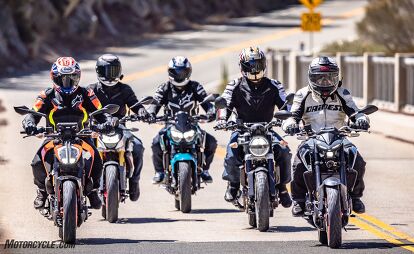


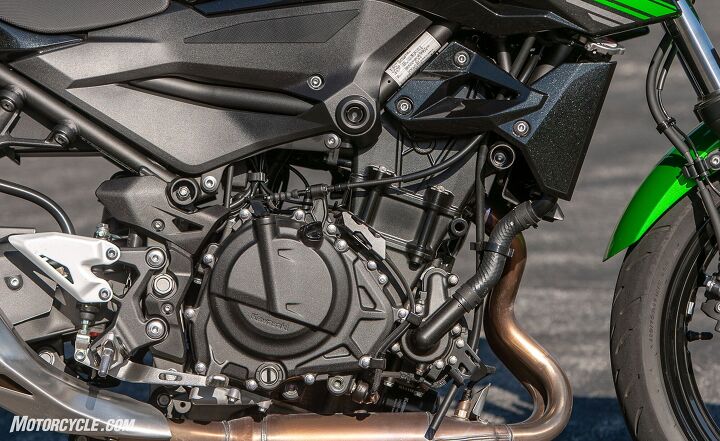
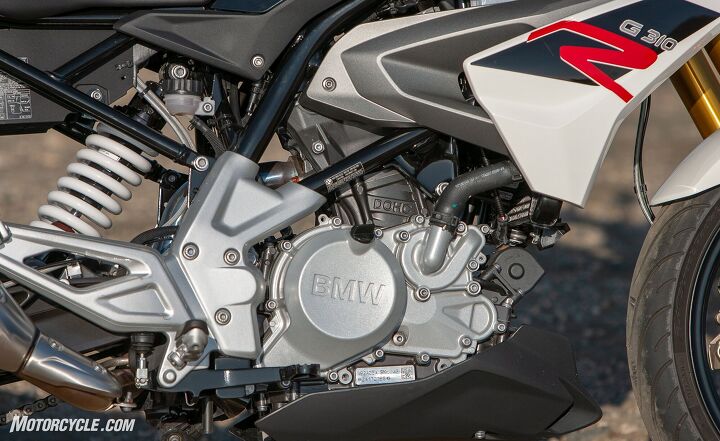















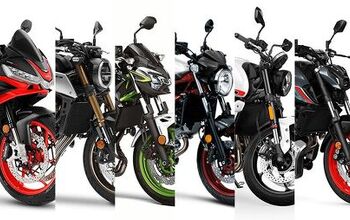

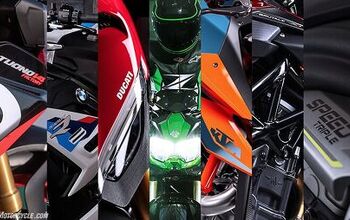













Comments
Join the conversation
Outlier here, but are the CSC/Zongshen 400s so beyond the pale that they couldn't included?
It doesn't speak well to KTM's manufacturing consistency when the same 373cc engine can have such varied power outputs. I highly doubt the tuning between the Husky and KTM is significantly different yet the HP/T numbers are significantly different.